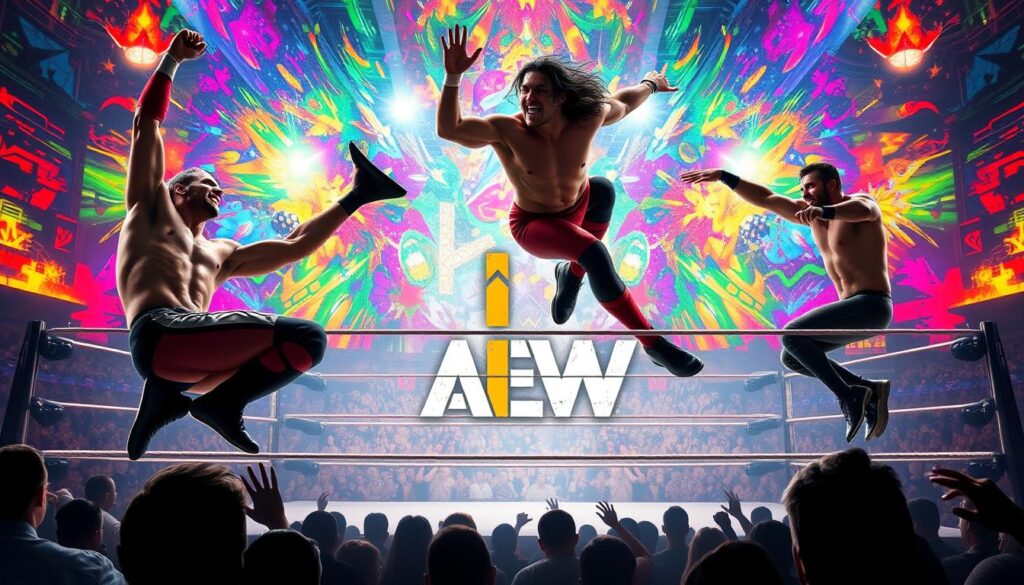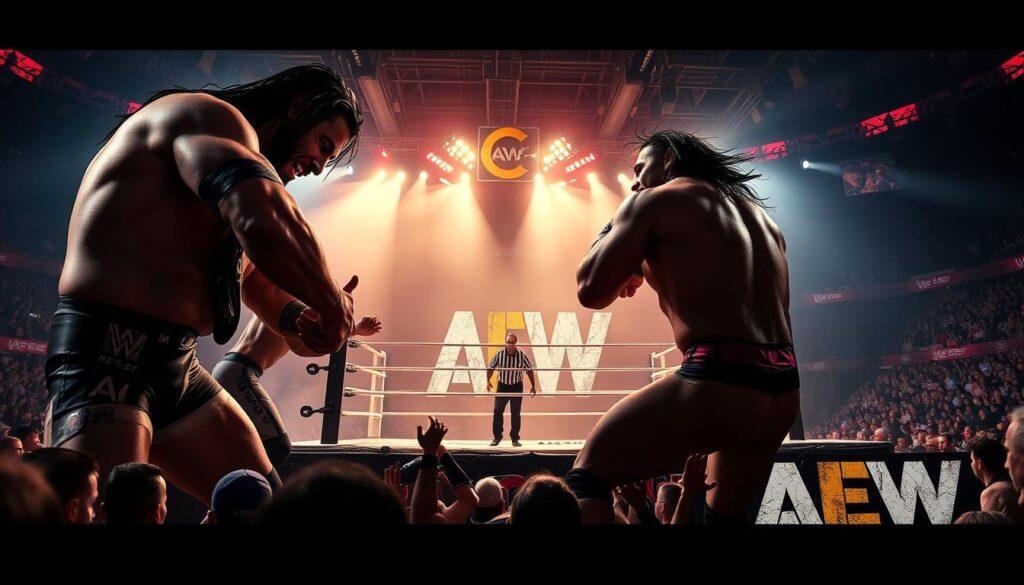Remember when streaming services made your cable package seem old-fashioned? That’s what’s happening in wrestling now. A new promotion, like the Netflix of body slams, is shaking things up. It honors old traditions while introducing new, exciting moves.
Mercedes Moné said it’s like watching hieroglyphics turn into holograms. She’s right. Sting’s career has spanned decades, while new wrestlers perform moves that would stun even Isaac Newton.
This isn’t just another battle for wrestling supremacy. Tony Khan’s venture combines ECW’s rebellious spirit with modern business savvy. It feels underground but plays in big arenas. The wrestlers come from all over, blending styles in a unique way.
While the old guard runs stadium shows, the real excitement is in this new lab. Here, wrestlers from different backgrounds come together. Each match asks: “What if we tried it this way instead?” The revolution is coming, and it will be seen by all.
Founding and Principles
Imagine Mark Zuckerberg starting Facebook in a wrestling ring, not a Harvard dorm. That’s the story of All Elite Wrestling. Billionaire fan Tony Khan launched AEW in 2019. He created a pro wrestling world with a unique twist.
Khan’s plan was to build a roster like Marvel’s Phase One. Each wrestler is a hero and a key part of the universe.
Let’s look at Khan’s strategy. Jon Moxley is like Captain America, a fierce rebel. Kenny Omega is Iron Man 2.0, mixing anime and comic book traits. Chris Jericho is like Loki, always changing his act.
The women’s division in AEW is groundbreaking. Dr. Britt Baker is a dentist and a deathmatch star. The Young Bucks make tag team wrestling exciting, like a Michael Bay movie.
| Element | AEW Approach | WWE Legacy |
|---|---|---|
| Match Philosophy | Sporting Code (Win/Loss Records) | Entertainment First |
| Talent Development | Indie Cred Meets TV polish | Performance Center Pipeline |
| Story Engine | Long-Term Comic Book Arcs | Soap Opera Rotations |
What makes AEW special? It’s the “Venn Diagram Principle,” where wrestling fans and newcomers meet. They’ve opened doors to New Japan stars, making matches exciting and unpredictable.
Khan’s vision is like a punk rock mixtape. He focuses on sports rankings, minimal promos, and video game-themed PPV events. It’s a fresh take on wrestling, challenging the status quo.
AEW’s Mission and Vision
Imagine wrestling as a live-action philosophy seminar. AEW turns its ring into a canvas, mixing athleticism with storytelling. This creates matches that cut through WWE’s scripted drama.
Take the three-way title match at Revolution 2024. Will Ospreay’s high-flying debut met Deonna Purrazzo’s submission mastery. It was a match so complex, it made Inception seem simple.
This isn’t just about ratings. It’s about changing what wrestling means. AEW’s founders wanted a “thinker’s wrestling promotion” five years ago. Mercedes Moné’s story shows they followed through. It’s not just about girl power, but Hannah Arendt meets hell in a cell.
AEW refuses to pick between substance and spectacle. Their famous matches are like Russian nesting dolls:
- Layer 1: Jaw-dropping athletic feats (see: Ospreay’s hidden blade strike)
- Layer 2: Psychological chess matches (Purrazzo’s limb-targeting strategy)
- Layer 3: Cultural commentary (Moné dismantling the “women’s division” ghetto)
AEW’s wrestling demands rewatches. It’s not just for counting near-falls, but to understand its meaning. When AEW calls itself “the alternative,” they’re not just challenging others. They’re reimagining what a wrestling company can be.
AEW’s Unique Selling Points
Imagine jazz improvisation versus Broadway choreography. That’s the sports entertainment arms race today. One side offers perfectly rehearsed shows, while the other excels in spontaneous action.
The 16,878 fans at Revolution 2024 set a new record. It was more than just a crowd; it was a cultural statement. Fans today want realness in their entertainment, just like ancient Romans wanted in gladiatorial fights.
AEW’s Tornado Tag matches are not just fights. They’re lessons in chaos theory. Weapons pop up unexpectedly, bodies crash through tables, and the crowd cheers wildly. It’s like freeform jazz, where unexpected moments create beauty.
WWE, on the other hand, is like a blockbuster movie. It’s all about perfect angles and scripted moments. But AEW lets performers create their own show as they go. This shows that different styles can coexist in wrestling, as long as they stay true to themselves.
AEW’s Major Events and Highlights
What happens when wrestling turns into a myth? The answer lies in famous AEW matches that mix sport and drama. Let’s look at two moments that changed how we see cultural impact. One was poetic, the other chaotic.
Sting’s last match at Revolution 2024 was more than a fight. It was a perfect circle of his career. Thirty-six years after his first match, he faced the Young Bucks. It was like Hamlet meets Edge of Tomorrow, but with more makeup.
This match was a deep dive into wrestling’s cycle. It asked: Do legends retire, or do they just start again?
Then, there was the All Star Scramble. Eight athletes packed 45 minutes of story into 15 minutes. It was like Michael Bay directing chess. The math was simple: (High spots + near falls) ÷ desperation = fun.
This event showed wrestling’s magic isn’t just about being athletic. It’s about turning a match into something special. Even a retirement match or a chaotic scramble can be a cultural hit, making us cheer, gasp, and sometimes throw popcorn.
Analyzing AEW’s Position in the Wrestling Industry
The wrestling world is like Game of Thrones with wrestlers in spandex. Alliances change quickly, power shifts with a single speech, and every battle for viewers is like facing winter. The big question is: Is Tony Khan’s AEW the necessary disruptor to WWE’s long rule, or just another challenger?
Let’s analyze it like a wrestling move. Using Porter’s Five Forces model, we see Khan’s strategy is like Ted Turner’s 90s wrestling battles. The Wednesday Night Wars are more than just TV ratings. They’re changing who watches wrestling and how much they pay for it. Mercedes Moné was right; it’s not just about keeping things the same. It’s about changing what “sports entertainment” means for today’s fans.
Look at the numbers. WWE might have more viewers, but AEW wins in the 18-49 age group, which is key for advertisers. It’s like David vs Goliath, with David having rich backers and a Dynamite time slot. But is AEW’s success just a short-term win, or is it a lasting change? Khan’s strategy might be the answer: less big show, more indie wrestling heart with big production.
As streaming sites look for live content, this fight could change the whole industry’s money game. So, grab your popcorn. The fight for the throne is far from over.
The Phoenix Effect: AEW’s Next Evolutionary Leap
Imagine a world where Will Ospreay’s 630 splashes are just a warm-up. Kris Statlander’s alien character gets AR updates live. The AEW roster is growing fast, with Revolution 2024 showing fans can’t guess what’s next.
Experts think the AEW roster could double by 2027. But it’s not just about numbers. Tony Khan’s team mixes lucha libre with MMA, creating new stars. Jade Cargill and Nick Wayne’s matches show AEW’s creative genius.
Looking ahead to 2030, the possibilities are exciting. Mercedes Moné might face a holographic foe in London. Darby Allin could coach his AI self in a time-travel story. AEW’s roster is where human talent meets digital innovation.
This isn’t just fantasy. AEW has a history of reinventing wrestling. They turn gimmicks into lasting stories, making ECW look old-fashioned. AEW doesn’t just follow trends; they create them with their roster.
AEW doesn’t pick between old and new. Chris Jericho and Skye Blue show both sides of wrestling. It’s like a quantum superposition, blending tradition with innovation. Fans get both the classic and the new in AEW’s ever-changing roster.


